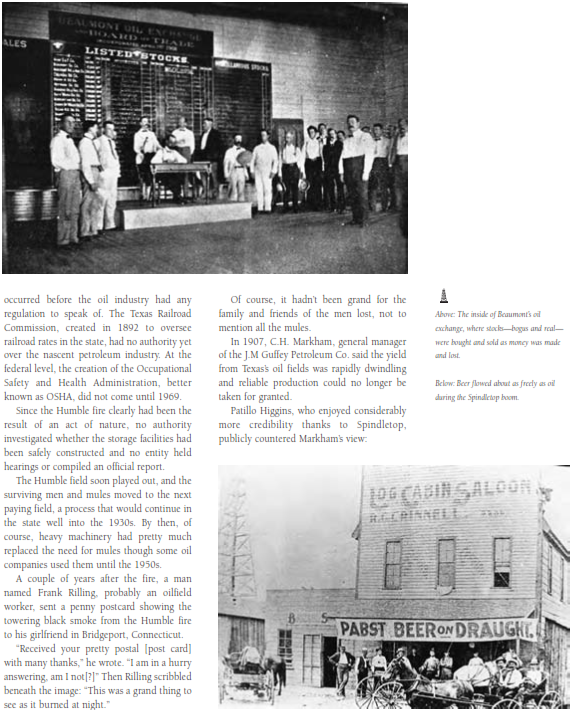CHAPTER 2
SPINDLETOP
" A GREAT OIL GEYSER "
Two years before the accidental petroleum discovery in Corsicana, a man who had only a few years before found God began a search for oil. His name was Patillo "Bud" Higgins.
His first discovery, his own spirituality, came in 1885 when he became converted at a Baptist revival. As devout a sinner as he would become a fervent Christian, Higgins had killed a Beaumont deputy city marshal in 1881. In the same gunfight which felled the lawman, a bullet fired by the officer mangled Higgins' left arm. When an infection set in, a doctor had to amputate most of the limb. Having lost an arm, he at least gained acquittal in court, his lawyer convincing a jury of his peers that Higgins had slain the officer in self-defense, not plain meanness.
As is the case with most important discoveries, Higgins's quest for oil was born of pragmatic need. Having transitioned from street fighter to businessman, in seeking the most efficient fuel to fire the kilns at a brick plant he operated, Higgins concluded oil would be the best bet. He had traveled to see out-of-state brick plants, finding they produced a better-fired brick after converting to oil.

Putting his Bible aside for a book on geology he had sent for, Higgins read by kerosene lantern light late into the night. In 1892, now fully convinced oil lay beneath the hill others called Spindletop (for a cone-shaped pine tree on top), he found three Beaumont businessmen willing to invest some money and organized the Gladys City Oil, Gas and Manufacturing Co. Gladys City, named for one of the girls in Higgins' Sunday school class, existed only in his imagination and the fanciful engraving on the letterhead of the company's stationery.
The street fighter turned businessman envisioned Gladys City as a future industrial metropolis, but just about everyone else in the area saw his proposed city and the oil play he predicted as nothing but a pipe dream. Higgins talked his partners into backing a test well on the hill, and in 1893 he hired a driller to spud in a well. Bad weather and slow going ate up available money and Higgins cancelled the test. He managed to raise money for a second test, but the driller did not have the right equipment for the job and the well ended up abandoned and plugged. Against his advice, other investors opted for a third try, which also flopped.
By this time, 1898, Higgins had sold his brick plant as well as his interest in the Gladys City company. What he did still have was leased acreage that included Spindletop, so if he could find someone willing to take a chance on another hole, he could still come out ahead if they found oil.
In 1899 he convinced mining engineer Anthony F. Lucas, then living in Washington, D.C., to bore ("boring" was the early term for drilling) another well on the hill. Lucas set about trying to raise money for a test, but given the history of failure at Spindletop, no one was willing to take a chance. Lucas ran the idea by the two gentlemen from Pennsylvania who had invested in Corsicana's play for a time, James M. Guffey and John M. Galey. With money they got from Pittsburg millionaire Andrew Mellon, the deal was on. But Higgins was not in on it. (By this time, so many different people had been contractually involved in one way or the other in the quest for oil at Spindletop that lawyers yet to be born would be assured a nice living from future litigation involving royalties.)






























